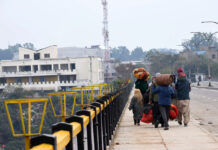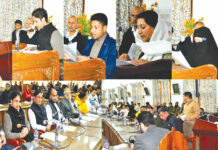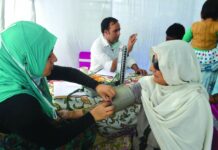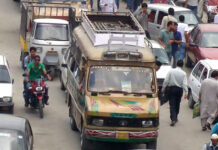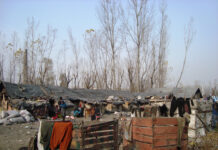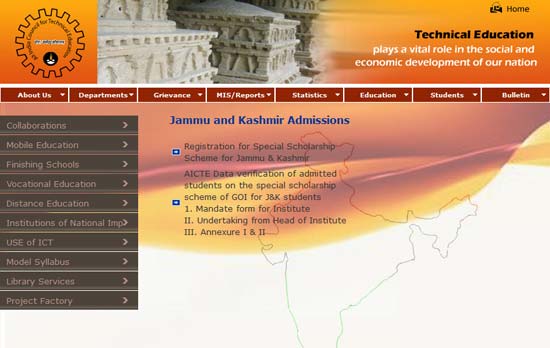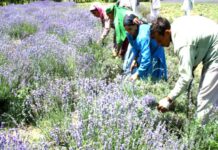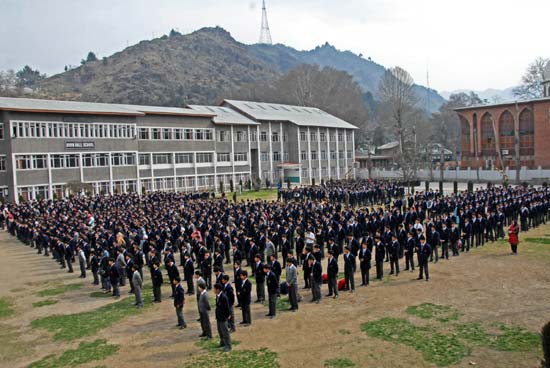The age old art of crafting copperwares is deep rooted in Kashmir’s culture. Rahiba R Parveen traces the history of handmade designer copperware in Kashmir and the threats it faces from machines
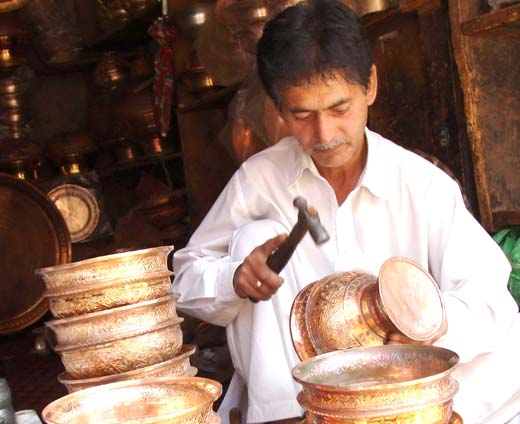 Kashmiri kitchens area a treat to be in. Besides the aroma of Saffron, lines of decorated utensils glittering in silver and gold is the façade.
Kashmiri kitchens area a treat to be in. Besides the aroma of Saffron, lines of decorated utensils glittering in silver and gold is the façade.
It’s indeed not the original gold or silver but items made from the copper metal. Copper, known locally as ‘traam’ is part of Kashmir’s culture since centuries.
Like any other place Kashmir too adapted to new technologies and trends from time to time. But there are certain crafts which have survived modernity and remained an important part of Kashmir’s culture. Designing copper utensils is one of them.
Zarief Ahmed Zarief, a prominent poet and historian, says copper is being used in the Valley since the 14 century, when Sultans ruled this Himalayan region. During the time of Sultan Zain-ul-Abidin (reigned: 1418-1419 and 1420-1470), the currency of the state were coins made of copper. “These coins were used till 1955 here and they followed with the tradition of copper utensils,” Zarief explains.
Zarief says that the Sufi saint, Mir Syed Ali Hamdani who travelled from Iran to spread Islam in Kashmir, was instrumental in making copper popular among natives. “He brought craftsmen from Central Asia to train locals in certain crafts,” says Zarief.
Apart from teaching locals shawl weaving and other crafts, Zarief says, that the artisans from Central Asia taught people to design copper utensils.
“Most of these copper utensils, which involve minute details of designing have been named in Persian,” says Zarief.
Some of them are ‘Tasht-Naer’ – a pot-set used to wash hands before and after the meals, particularly during wedding feasts; ‘Tream’ – a round copper plate used during feasts to serve food for four and ‘Samovar’ – a unique wide cylindrical urn with a chimney, in which charcoal is burned, to prepare tea in the cylinder around it. While the origin of Samovar is debatable as some historians believe it to be Russian, that does not make it any less a part of the Kashmiri households.
The process of turning raw copper into a decorative utensil passes through many hands and stages.
“Kashmir used to be copper rich. Copper was extracted from mines in Bandipore,” says Zarief, “However the mines were subsequently closed down rendering Kashmir dependent on India for copper imports.”
The first stage is to melt wires and sheets, brought from outside, to make different shapes. Artisans who make circular hard items like handles, stands, top borders for Samovars, Tasht Naer etc. out of the melted copper are called Barak Saaz’s.
In the next stage it passes through a Chargar’s hand who gives the raw metal finishing touches to make it smooth. Then the finished product is sent to a Naqashqar, who engraves traditional designs on the finished metal. Then comes the final stage, where a Kalai Saaz polishes the engraved utensil with lead to make it look like silver.
In the old city, SR Ganj area has many shops which flash various decorated pieces of copper items. Mostly these coppersmiths have inherited this business from their ancestors. Ghulam Rasool, 70, runs a shop near Alie Kadal which was his father’s. His two sons have also joined him after taking a bachelor’s degree.
“I have made sure that my sons work with me,” says Rasool, “I wish more and more people should come forward and do not let the art die.”
It is an old age custom in the valley to gift copperware to their daughters on wedding and other occasions. Rasool said three decades back people opted for simple plain plates, glasses, Samovars and other items but slowly the trend of ‘Kandkair’ which means carved with designs, took over.
Ajaz Ahmed Shah who has been in the business from last 12 years says there is more variety adding to it.
“Right now we have more than 7 types of Samovar’s only,” Shah says.
He also said that though urban population is slightly choosy in buying items but people who love and understand their tradition are keen to keep these engraved utensils as collectables at their homes.
In 2006, the State Legislative Assembly enacted J&K Prohibition on Manufacture of Specified utensils (by machine) Act 2006. The aim to safeguard age old art of manufacturing handmade items like Kani Shawals, copper ware etc.
There are disputes within the people involved in the copperwares. While some say the machines are killing their means of bread-earning, the people who afford the machines refute that the increasing demand in the production could only be solved by the later.
The President of the 70-year-old Copper Worker’s Trade Union, Yousuf Ahmed Kokru opposes the machine work in manufacturing copperware. He owns a small workshop where his son, who holds a Masters in Science, works by his side.
“Thousands of people are still dependent on this trade but people with vested interests are creating hindrances,” Kakru says.
He laments that even after the act has been passed there are parts of the city where machine work is still carried on. “If this is not stopped completely, we are going to come out to stage protests against the government,” said Kakru.
However, few coppersmiths like Ajaz Ahmed Khan of Saraf Kadal, are in favour of quashing the law prohibiting use of machines.
“There is a huge demand and people want variety. In today’s age everything is produced with the help of machines, so why not copperware,” said Khan.
Zarief maintains that machines should only be used for easing off a bit of labour involved in the craft.
“Some things get hard for the artisans to handle and machines should come into play at such places,” says Zarief.
Otherwise, Zarief feels that the hand-made work is an art and must be preserved.


